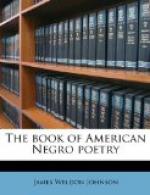I make here what may appear to be a more startling statement by saying that the Negro has already proved the possession of these powers by being the creator of the only things artistic that have yet sprung from American soil and been universally acknowledged as distinctive American products.
These creations by the American Negro may be summed up under four heads. The first two are the Uncle Remus stories, which were collected by Joel Chandler Harris, and the “spirituals” or slave songs, to which the Fisk Jubilee Singers made the public and the musicians of both the United States and Europe listen. The Uncle Remus stories constitute the greatest body of folklore that America has produced, and the “spirituals” the greatest body of folk-song. I shall speak of the “spirituals” later because they are more than folk-songs, for in them the Negro sounded the depths, if he did not scale the heights, of music.
The other two creations are the Cakewalk and ragtime. We do not need to go very far back to remember when cakewalking was the rage in the United States, Europe and South America. Society in this country and royalty abroad spent time in practicing the intricate steps. Paris pronounced it the “poetry of motion.” The popularity of the cakewalk passed away but its influence remained. The influence can be seen to-day on any American stage where there is dancing.
The influence which the Negro has exercised on the art of dancing in this country has been almost absolute. For generations the “buck and wing” and the “stop-time” dances, which are strictly Negro, have been familiar to American theatre audiences. A few years ago the public discovered the “turkey trot,” the “eagle rock,” “ballin’ the jack,” and several other varieties that started the modern dance craze. These dances were quickly followed by the “tango,” a dance originated by the Negroes of Cuba and later transplanted to South America. (This fact is attested by no less authority than Vincente Blasco Ibanez in his “Four Horsemen of the Apocalypse.”) Half the floor space in the country was then turned over to dancing, and highly paid exponents sprang up everywhere. The most noted, Mr. Vernon Castle, and, by the way, an Englishman, never danced except to the music of a colored band, and he never failed to state to his audiences that most of his dances had long been done by “your colored people,” as he put it.
Any one who witnesses a musical production in which there is dancing cannot fail to notice the Negro stamp on all the movements; a stamp which even the great vogue of Russian dances that swept the country about the time of the popular dance craze could not affect. That peculiar swaying of the shoulders which you see done everywhere by the blond girls of the chorus is nothing more than a movement from the Negro dance referred to above, the “eagle rock.” Occasionally the movement takes on a suggestion of the, now outlawed, “shimmy.”




